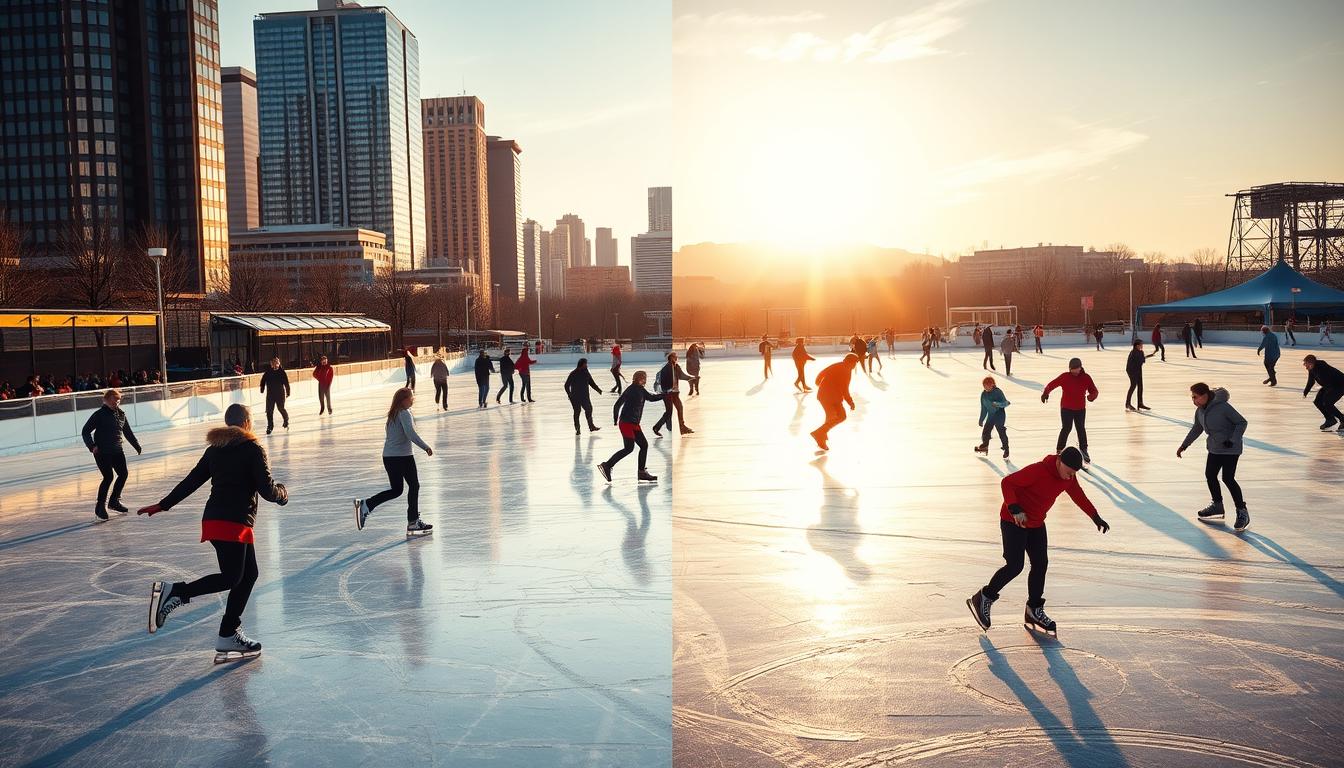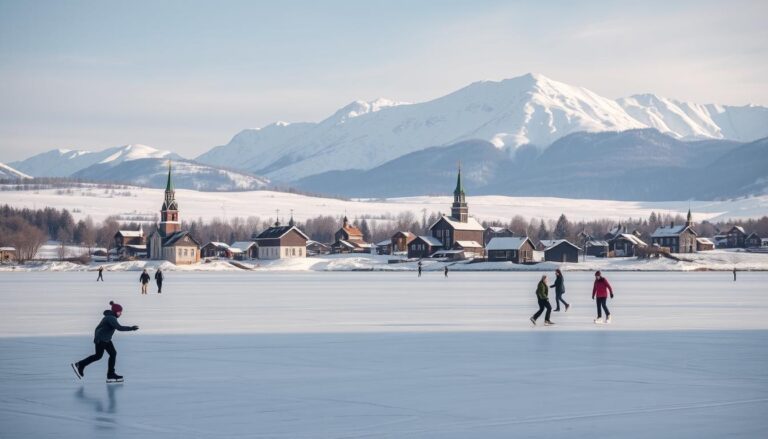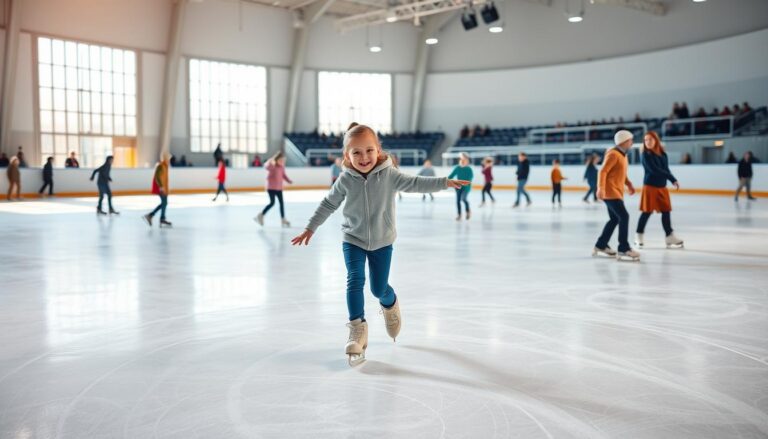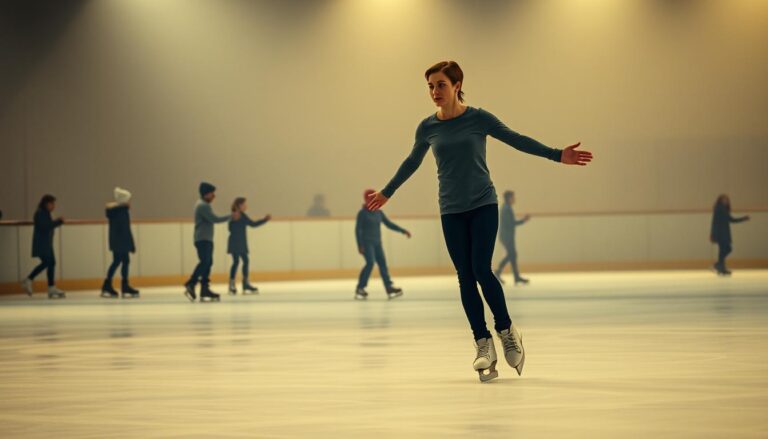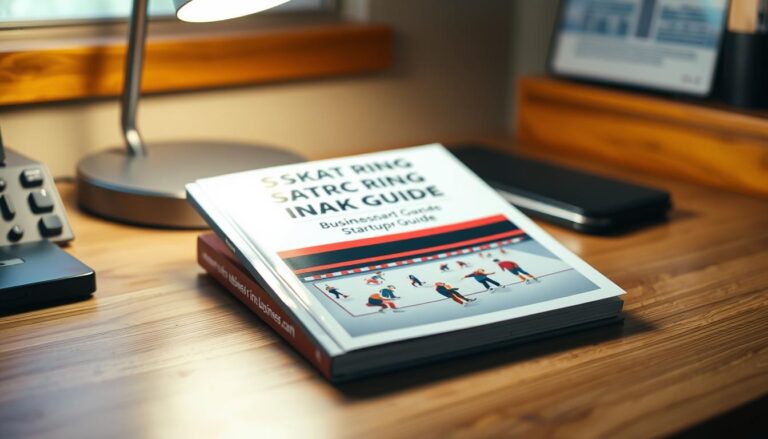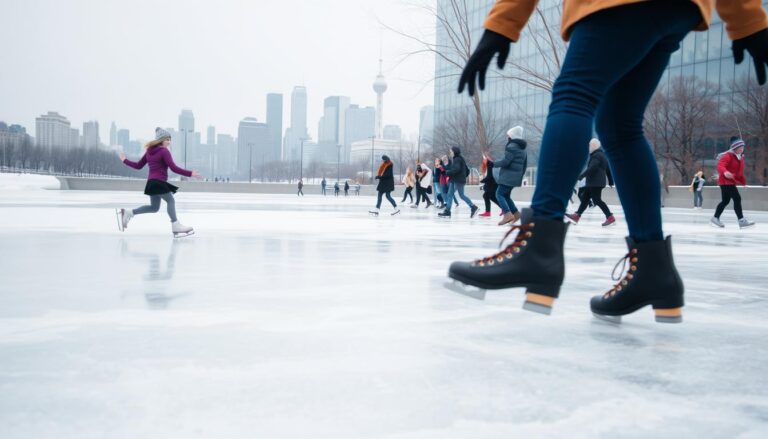Is Ice Skating Like Roller Skating? Similar in Some Ways
Gliding on a smooth surface needs skill, balance, and courage. Whether it’s ice or a roller skating floor, the excitement is the same. The question “is ice skating like roller skating” opens up a world of similarities and challenges.
Ice skating and roller skating are more than just the surface. They both require strong core, precise control, and a readiness for surprises. Both attract beginners and pros with their rhythmic flow and freedom.
When you first step on the surface, whether ice or wood, your muscles prepare. Your balance shifts, and you start learning a new way of moving. Each sport has its own learning path, full of challenges and thrills.
Many athletes and hobbyists talk about the links between ice and roller skating. Some train in both, seeing the skills they gain in one help in the other. Balance, edge control, and moving forward are key skills in both.
From Olympic skaters to weekend fun-seekers, all ages and levels find joy in these sports. They improve fitness, learn new skills, or just have fun. Knowing the differences between ice and roller skating opens up new possibilities.
This guide will dive into the details of ice skating and roller skating. We’ll look at equipment, techniques, and the physical and mental benefits. Get ready to explore the exciting similarities and unique aspects of each sport.
Understanding the Basics: Ice Skating vs Roller Skating
For centuries, people have loved gliding on surfaces. Ice skating and roller skating are two fun ways to do this. They share some basics but also have their own unique experiences.
Definition and History of Both Sports
Ice skating and roller skating have deep histories. Ice skating started as a way to move in winter in Nordic countries. It dates back to 3000 BCE with bone skates. Roller skating began in the 18th century for moving on smooth surfaces in cities.
- Ice skating: Prehistoric transportation method
- Roller skating: 18th-century urban recreational invention
- Both sports evolved from practical necessity to competitive disciplines
Evolution of Skating Equipment
The gear for ice and roller skating shows their main differences. Ice skates have metal blades for ice, while roller skates have wheels for ground. New tech has changed both skating gear a lot.
| Equipment Feature | Ice Skating | Roller Skating |
|---|---|---|
| Primary Surface Contact | Metal Blade | Polyurethane Wheels |
| Typical Environment | Frozen Rinks/Lakes | Smooth Floors/Outdoor Paths |
| Skill Difficulty | More Technical | Generally Easier |
Popular Venues and Settings
Ice skating and roller skating can be enjoyed in many places. You can skate in indoor rinks, outdoor parks, and arenas. Urban parks, specialized rinks, and community centers welcome skaters of all levels.
Whether you prefer ice or wheels, both offer great chances for fun, fitness, and personal growth.
Core Similarities Between Ice and Roller Skating
Gliding on ice or wheels might seem different, but these sports share key similarities. Both require balance, coordination, and muscle use. This makes them fun and challenging.
Ice skating and roller skating have many connections. These include:
- Fundamental body mechanics of balance and weight distribution
- Similar muscle groups activated during movement
- Cardiovascular fitness benefits
- Technique-driven performance
Both sports need edge control, rhythmic motion, and spatial awareness. Skaters must build strong core muscles, leg strength, and focus. This helps them move well on their chosen surface.
| Aspect | Ice Skating | Roller Skating |
|---|---|---|
| Primary Muscles Used | Quadriceps, Calves, Core | Quadriceps, Calves, Core |
| Balance Requirement | High | High |
| Cardiovascular Intensity | Moderate to High | Moderate to High |
Starting out in either sport can be easier because of shared skills. Understanding weight shifting, edge control, and smooth motion is key. Whether on ice or wheels, the core of skating is the same.
Essential Equipment and Gear Comparison
When you start skating, knowing the right gear is key. Ice skating and roller skating have their own special equipment. The right gear can make a big difference in how well you skate and how comfortable you feel.
Looking at ice skating and roller skating, you’ll see big differences in their gear. These differences affect how you move, balance, and enjoy your skating.
Skate Structure and Design
Ice skates and roller skates are built differently:
- Ice skates have a thin metal blade for ice
- Roller skates have multi-wheeled bases for smooth movement
- The length of the blade and the type of wheels change how you skate
Protective Equipment Requirements
Wearing the right safety gear is important for both ice and roller skating. It helps keep you safe and builds confidence, which is great for new skaters.
| Protective Item | Ice Skating | Roller Skating |
|---|---|---|
| Helmet | Recommended | Essential |
| Knee Pads | Optional | Highly Recommended |
| Wrist Guards | Optional | Essential |
Maintenance and Care Tips
Keeping your gear in good shape is important. Ice skating compared to roller skating needs different care:
- Clean blades/wheels after each use
- Store in dry, cool places
- Check for wear and damage often
- Sharpen ice skate blades now and then
- Replace roller skate wheels when they’re worn out
Knowing about these differences will help you choose the right gear. This way, you can skate safely and have more fun.
Balance and Body Positioning Techniques
Learning to balance is key when you explore ice skating and roller skating. Both need you to position your body right and use your core to move smoothly. This is true whether you’re on ice or wheels.
When you compare ice skating to roller skating, you find important balance techniques that work for both:
- Maintaining a low center of gravity
- Keeping knees slightly bent
- Engaging core muscles
- Distributing weight evenly
Proper body alignment is essential in both ice and roller skating. Stand with your feet shoulder-width apart. Keep your weight evenly distributed between your feet.
Skaters need to practice balance to get it right. Key techniques include:
- Keeping head up and looking forward
- Relaxing shoulders
- Positioning arms for counterbalance
- Maintaining a slight forward lean
Even though the surface is different, the balance basics are the same. How well you control your body’s position will help you succeed in both sports.
Pro tip: Practice balance exercises off the skating surface. This will help improve your skills and boost your confidence on wheels or blades.
Basic Movement and Stopping Methods
Learning to move is key in ice skating and roller skating. Whether you’re on ice or a roller surface, the basics are similar. Knowing these skills helps you skate with confidence.
Ice skating and roller skating share many movement techniques. Both need balance, power, and precision to move and stop well.
Forward Skating Techniques
Forward skating is the base for both ice and roller skating. The main points are:
- Push and glide motion
- Weight transfer between legs
- Maintaining a low center of gravity
- Proper ankle and knee alignment
Backward Skating Approaches
Backward skating is different but the core technique is the same for both. The main steps are:
- Start with a slight sideways stance
- Push outward with the inside edges of your skates
- Maintain a balanced, low body position
- Practice smooth weight shifting
Emergency Stopping Skills
Stopping is vital in both ice and roller skating. Safety is the top priority when learning these skills. Different surfaces need slightly different methods:
- T-stop method (works for both)
- Hockey stop for ice skating
- Heel brake technique for roller skating
- Controlled sliding approach
Practicing these basics boosts your confidence and skill in both sports. Remember, regular practice makes these skills smooth and natural.
Is Ice Skating Like Roller Skating: A Detailed Analysis
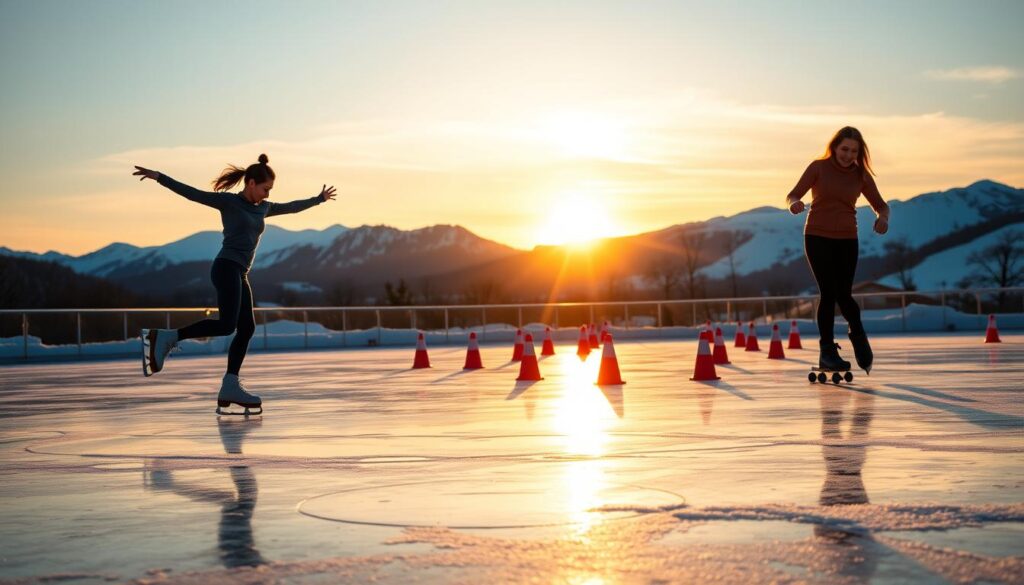
Exploring the world of skating shows interesting links between ice and roller skating. At first, they seem very different. But, they share surprising similarities that catch the eye of both new and seasoned skaters.
Looking at ice skating and roller skating, we see some key differences:
- Surface interaction differs significantly between ice and roller skating
- Balance techniques require similar core muscle engagement
- Both sports demand precise body control and coordination
The physics of gliding is key to understanding the connection between ice and roller skating. Ice skaters use a thin blade to glide on ice, creating a smooth path. Roller skaters, on the other hand, use wheel friction and momentum.
It’s interesting to see how skills from one type of skating can be used in the other. Body positioning, weight distribution, and basic movement patterns are very similar.
| Aspect | Ice Skating | Roller Skating |
|---|---|---|
| Surface Type | Ice | Wooden/Concrete Rinks |
| Primary Equipment | Bladed Skates | Wheeled Skates |
| Skill Complexity | High Precision | Varied Difficulty Levels |
Ice skating and roller skating show both subtle differences and surprising similarities. Whether you’re gliding on ice or rolling on a rink, the joy of skating is always the same.
Learning Curve and Skill Development
Starting to skate is both fun and tough. Ice skating and roller skating have their own unique skills to learn. Each one needs different muscle memory and balance skills, making the start exciting and hard.
When you first start, you’ll face different challenges in ice skating and roller skating:
- Ice skating needs precise ankle control because of the narrow blade
- Roller skating is more stable for beginners
- The surface feels very different between ice and roller skating
Both sports have a structured learning path. Beginners start with basic balance and movement techniques. Ice skaters learn edge control, while roller skaters work on weight distribution and wheel management.
Here are the typical skill development stages:
- Learning basic standing and balancing techniques
- Mastering forward movement
- Developing stopping methods
- Advancing to more complex turns and transitions
Skating instructors say to be patient and practice often. Ice skating is harder because of the slippery surface. But roller skating is more forgiving at first. No matter your choice, hard work and proper technique are essential to get good at skating.
Surface Differences and Their Impact
Skating fans know that the surface matters a lot. It changes how you move and perform. Ice and roller skating have different surfaces, affecting your technique and skill.
Ice skating and roller skating have distinct surfaces. Ice is smooth and slippery, needing precise balance. Roller skating surfaces are more stable and grippy.
Ice Properties and Skating Dynamics
Ice skating is different from roller skating in many ways. The ice’s smoothness and slippery nature offer a unique glide. This glide is due to:
- Extremely low friction
- Temperature-dependent hardness
- Self-lubricating properties
- Constant micro-melting during movement
Friction and Resistance Factors
Knowing about surface resistance helps skaters improve. Here’s a look at the friction levels:
| Surface Type | Friction Level | Skating Difficulty |
|---|---|---|
| Ice Rink | Very Low | High Technical Skill Required |
| Wooden Roller Rink | Moderate | Medium Technical Skill |
| Outdoor Concrete | High | Lower Technical Skill Needed |
Each surface requires special skills. Ice skaters need to control their edges and balance. Roller skaters focus on keeping their speed steady on different grounds.
Physical Benefits and Muscle Engagement

Skating is a full-body workout that changes your fitness routine. Ice skating and roller skating both offer great physical benefits. They engage many muscle groups at once, making them excellent low-impact cardio exercises.
When comparing ice skating and roller skating, you’ll see they work your body in special ways. Your core muscles keep you balanced, and your lower body muscles push you forward.
- Core muscles stabilize your entire body
- Quadriceps and hamstrings drive forward momentum
- Calves provide critical pushing power
- Glutes activate during turning and stopping
Let’s look at the muscle engagement and calorie-burning of these sports:
| Muscle Group | Ice Skating Impact | Roller Skating Impact |
|---|---|---|
| Core Muscles | High Engagement | High Engagement |
| Leg Muscles | Intense Workout | Intense Workout |
| Calories Burned (per hour) | 450-700 calories | 400-600 calories |
Both skating styles boost balance, coordination, and body awareness. Your proprioceptive skills will dramatically enhance as you master each movement. This creates a strong mind-body connection that goes beyond the rink.
Ready to change your fitness journey? Grab your skates and see the amazing physical benefits of these dynamic sports!
Common Mistakes Beginners Make in Both Sports
When starting out with ice skating or roller skating, beginners face similar hurdles. These can make their first tries tough. It takes patience and knowing common mistakes to get better.
Skating might seem easy, but it’s not. Mastering ice skating vs roller skating means beating many basic mistakes. These can hurt your confidence and how well you do.
Balance-Related Errors to Watch Out For
Keeping your body right is a big challenge for new skaters. Here are the top balance mistakes:
- Keeping legs too stiff and rigid
- Leaning too far forward or backward
- Looking down instead of maintaining a forward gaze
- Tensing up muscles, which reduces natural movement
Speed Control Challenges
Controlling your speed is key in both ice and roller skating. New skaters often make these speed errors:
- Panicking when moving too quickly
- Failing to distribute weight correctly
- Not understanding proper stopping techniques
- Overcompensating with sudden movements
Pro tip: Practice controlled movements and focus on gradual technique improvement.
Every pro skater was once a beginner. Be patient with yourself and you’ll get better. You’ll build confidence on your skates over time.
Advanced Techniques and Transitions
Skating fans eager to improve will find ice skating and roller skating share many advanced techniques. These techniques require athletes to master movement and body control. This pushes them to new heights.
Skaters at the advanced level work on skills that go beyond the surface they skate on. Both ice and roller skating need precise weight shifts, balance, and body positioning. It’s in these complex moves that the two sports show their most striking similarities.
- Spin Techniques: Mastering rotational movements
- Jump Mechanics: Developing aerial control
- Edge Work: Perfecting directional changes
- Footwork Patterns: Creating fluid transitions
Many pros skate on both ice and wheels to get better. This way, they build skills that work on any skating surface.
| Technique | Ice Skating | Roller Skating |
|---|---|---|
| Spin Rotation | Blade-driven momentum | Wheel-based rotation |
| Jump Height | Longer vertical lift | Shorter controlled jumps |
| Edge Control | Sharper blade edges | Smoother wheel transitions |
Getting good at advanced skating techniques takes hard work, practice, and a desire to try new things. Those who take on these challenges can achieve amazing things in their skating career.
Safety Considerations for Both Activities
Skating has its own risks, whether on ice or wheels. Knowing the differences helps you stay safe and enjoy skating more.
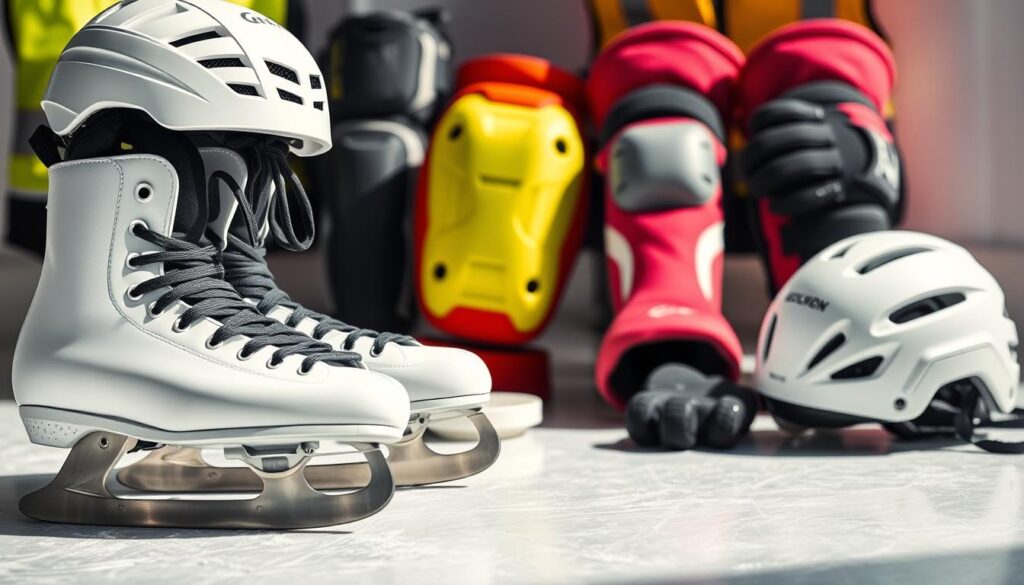
Both ice and roller skating need careful safety measures. They share some similarities but also have their own unique needs. It’s important to pay attention to personal protection and the environment.
Risk Assessment in Skating
Each skating surface has its own risks. Ice skating is slippery, while roller skating deals with different terrains and friction.
- Ice skating risks include:
- Slipping on hard surfaces
- Sharp blade-related injuries
- Cold temperature exposure
- Roller skating risks include:
- Uneven surface accidents
- Wheel-related instability
- Outdoor terrain challenges
Injury Prevention Strategies
Staying safe involves the right gear, technique, and awareness. Here are key strategies for both ice and roller skating:
| Prevention Strategy | Ice Skating | Roller Skating |
|---|---|---|
| Protective Gear | Padded shorts, helmets | Knee/elbow pads, wrist guards |
| Skill Development | Balance training | Core strength exercises |
| Technique Focus | Edge control | Weight distribution |
Learning how to fall safely is key in both ice and roller skating. Practice falling to reduce injury risk. Always wear the right gear and build your skills slowly for a safe skate.
Cost Comparison and Accessibility
Choosing between ice skating and roller skating is more than just skill. It’s about understanding the cost and how easy it is to get into each sport. Your budget and what’s available in your area are key to making a choice.
Roller skating usually costs less at first. You can get basic roller skates for $50-$100. Ice skates for beginners can cost $100-$300.
- Roller Skating Startup Costs:
- Basic skates: $50-$100
- Protective gear: $30-$70
- Rink admission: $5-$15 per session
- Ice Skating Startup Costs:
- Entry-level skates: $100-$300
- Protective gear: $50-$100
- Rink admission: $10-$25 per session
Roller skating is available all year, indoors and outdoors. Ice skating depends on where you live and the season. Places with cold weather have more ice skating options, while warmer areas might have less.
| Factor | Roller Skating | Ice Skating |
|---|---|---|
| Venue Availability | Indoor/Outdoor Year-Round | Seasonal, Location-Dependent |
| Average Monthly Cost | $50-$100 | $75-$150 |
| Learning Curve Expense | Lower | Higher |
Your local community centers, parks, and recreational facilities offer affordable options. They often have rental equipment and classes for beginners. This helps you save money while trying out these fun sports.
Social Aspects and Community Engagement
Skating brings people together in unique and exciting ways. Whether you’re gliding on ice or rolling on wheels, the social connections you’ll build are incredibly rewarding. The similarities between ice skating and roller skating extend far beyond the technical skills – they create vibrant communities that welcome enthusiasts of all ages and skill levels.
Group activities play a key role in both ice skating and roller skating experiences. These social environments offer many chances to connect:
- Beginner group lessons for skill development
- Themed skating nights at local rinks
- Social clubs for regular meetups
- Fitness-focused skating classes
Group Activities and Classes
Both ice skating and roller skating provide fun, interactive learning environments. Participants can join classes for all skill levels, from beginners to advanced skaters.
Competition Opportunities
The ice skating and roller skating comparison reveals exciting competitive landscapes. From local amateur events to professional leagues, skaters can challenge themselves and showcase their skills. Competitive platforms include:
- Local recreational tournaments
- Regional championships
- National skating competitions
- International skating events
Joining a skating community opens doors to personal growth, friendship, and shared passion. Your skating journey can transform from a solo activity into a rich, supportive social experience.
Professional Career Paths in Both Sports
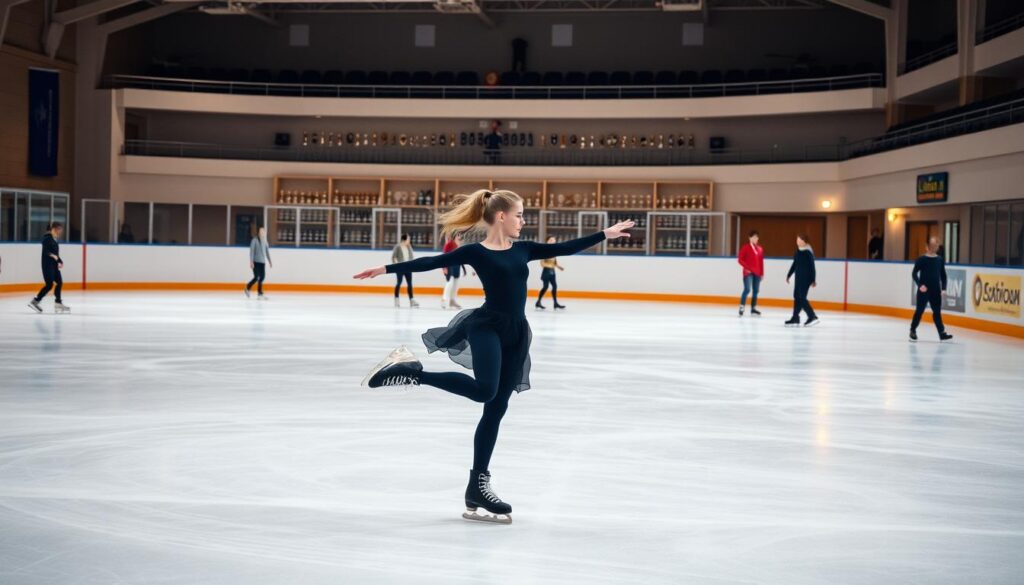
Skating offers exciting professional opportunities for passionate athletes. Whether you’re drawn to ice skating or roller skating, multiple career paths exist for dedicated individuals. The differences between ice skating and roller skating create unique professional landscapes that cater to diverse talents.
Professional skating careers span several dynamic fields:
- Competitive Skating: Olympic-level ice skating and national roller skating competitions provide high-performance opportunities
- Performance Entertainment: Ice shows and roller skating troupes welcome skilled performers
- Coaching and Training: Develop skills by teaching new generations of skaters
- Sports Management: Work behind the scenes in skating organizations
When comparing ice skating to roller skating career paths, athletes discover distinct advantages. Ice skating often offers more international recognition, while roller skating provides broader community engagement opportunities.
Income varies across disciplines. Professional ice skaters can earn substantial sponsorships and competition prizes. Roller skating professionals might find lucrative careers in roller derby teams or specialized performance groups.
Key skills for success include:
- Technical mastery of skating techniques
- Physical fitness and endurance
- Marketing and personal branding
- Adaptability across different skating styles
Aspiring professionals should invest in training, network within skating communities, and remain passionate about continuous skill development.
Conclusion
Exploring if ice skating is like roller skating shows us a world of athletic skills and shared experiences. At first, these sports might seem different. But they both need balance, motion, and personal growth.
Skaters on ice or wheels face unique challenges and rewards. They build core strength, coordination, and muscle memory. Learning either sport means understanding body mechanics and precise movements.
The choice between ice skating and roller skating depends on personal preference and goals. Some love ice skating’s crisp precision, while others enjoy roller skating’s flexibility. The joy of movement and the thrill of learning are common to both.
Your skating journey is just starting. Embrace the learning, stay curious, and remember that every expert began as a beginner. Whether on ice or wheels, the key is to enjoy the journey.
